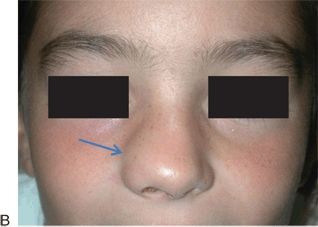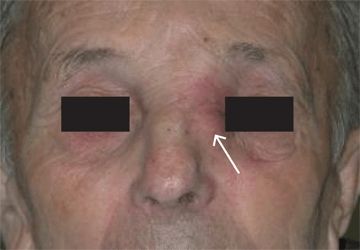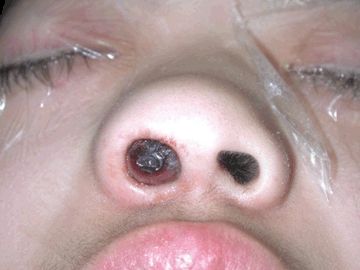
FIGURE 22.1 Patients with a tumor of the anterior cranial base with significant intranasal component presenting with a mass in the left medial canthal region (A) and an external nasal deformity with blunting of the right nasal–facial crease (arrow) (B).

FIGURE 22.2 Advanced sinonasal carcinoma with skin involvement.

FIGURE 22.3 Malignant tumor of the anterior cranial base with hemorrhage prolapsing out of the nasal cavity.
INDICATIONS
The role and timing of surgery in patients with malignant neoplasms of the anterior cranial base depends upon the biology of the primary neoplasm and the patient’s willingness to accept craniofacial resection and its possible complications. Surgery remains the standard of care in the management of patients with minor salivary gland tumors of the anterior cranial base and lacrimal region, some neuroendocrine carcinomas, and adenocarcinomas. Sinonasal undifferentiated carcinoma, poorly differentiated squamous cell carcinomas, and other very high-grade neoplasms may be treated with multidrug neoadjuvant chemotherapy followed by definitive chemoradiation. The management of olfactory neuroblastoma (ONB) remains somewhat controversial in that some groups favor primary nonsurgical therapy with surgical salvage while others believe ONB is most amenable to treatment with definitive surgery.
CONTRAINDICATIONS
Contraindications for craniofacial resection via lateral rhinotomy include aggressive histology with poor prognosis, extensive involvement of the facial skin (limiting ability to obtain negative margins), radiographic evidence of extensive perineural invasion, poor performance status, and extensive involvement of the brain parenchyma and clinical or radiographic evidence of metastatic disease. A relative contraindication is lateral rhinotomy and partial maxillectomy in an only-seeing eye.
PREOPERATIVE PLANNING
Computed tomography (CT) and magnetic resonance imaging (MRI) should be viewed as complementary imaging modalities, and both are helpful in the preoperative evaluation of a patient undergoing craniofacial resection with lateral rhinotomy. The superior bony detail rendered by the CT provides useful information regarding the amount of bone destruction of the ethmoid labyrinth and nasal wall particularly on the contralateral side of the tumor. The MRI is able to more clearly identify transcranial extension of tumor and to delineate tumor from retained secretions in the sinuses (Fig. 22.4). The role of combined positron emission tomography–computed tomography (PET–CT) scanning in the preoperative evaluation of advanced skull base tumors is limited to the detection of cervical and retropharyngeal adenopathy and distant metastatic disease. I obtain PET–CT scan on patients with high-grade malignances and any patient presenting with cervical lymphadenopathy.

FIGURE 22.4 Postcontrast MRI of ONB with penetration of the cribriform plate and fovea ethmoidalis and involvement of the dura of the anterior cranial fossa.
SURGICAL TECHNIQUE
When combined with bifrontal craniotomy for anterior craniofacial resection, the lateral rhinotomy is usually performed after the intracranial portion of the procedure, assessment of intracranial and intradural margins, and the reconstruction of the dura of the anterior cranial fossa.
The skin incision is marked prior to infiltration with local anesthetic (lidocaine 1:100,000 with epinephrine) to avoid distortion of the aesthetic units of the nose that are integral to the design of the incision. Ophthalmic ointment is placed in both eyes, and a suture tarsorrhaphy can be placed on the contralateral side to protect the cornea. I place a plastic corneal protector on the ipsilateral side to obviate the need for a tarsorrhaphy, which could distort the skin and make monitoring the eye more difficult. The incision begins under the ipsilateral eyebrow just medial to the supraorbital notch palpated in the supraorbital rim. The incision is beveled parallel to the hair follicles of the upper eyebrow and camouflaged along the inferior border of the eyebrow. The incision is extended inferiorly into the medial canthus where it is broken with the soft “W” or “Z” that will prevent webbing of the medial canthus. The apices of the broken incisions should be broad enough to prevent necrosis of the distal tip of the skin triangle, and monopolar cautery should be avoided in this portion of the incision. Failure to break the incision in the medial canthus or necrosis of the distal portions of the incision will lead to unsightly webbing of the medial canthus. The incision is then extended inferiorly respecting the aesthetic units of the nose in a vertical line along the nasal–maxillary crease, around the alar crease and into the philtrum. Traditionally, the lateral rhinotomy incision terminated into the nasal vestibule; however, this places the integrity of the lateral attachment of the lower lateral nasal cartilage at risk resulting in nasal valve collapse. Based on the extent of resection necessary, a separate ipsilateral gingiva–buccal incision can be added to increase exposure to the maxillary antrum. Alternatively, the incision can be extended inferiorly to include an upper lip split if a radical maxillectomy is required. I have found that the subciliary extension (Weber-Fergusson incision) often results in an unfavorable functional and aesthetic result and is rarely needed even for radical maxillectomy. Upper and lower eyelid transconjunctival incisions can be added for orbital exenteration. Should bilateral exposure of the superior ethmoid vault be necessary, the incision can be extended across the midline with a 15- to 20-mm horizontal extension across the nasal dorsum (Fig. 22.5) at the level of the nasion.




